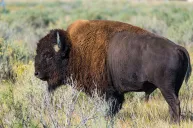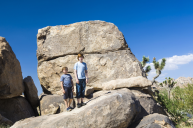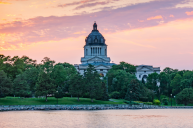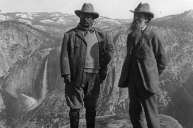In 1883, a kid with glasses from New York stepped off a train in western North Dakota. He'd come to the badlands intent on hunting bison. Seeing this city slicker in America's backcountry, you wouldn't know you were looking at the future 26th president of the United States.
Near North Dakota's border with Montana, along the winding banks of the Little Missouri River, you'll find Theodore Roosevelt National Park. Open year-round, it is one of the National Park Service's most stunning properties. Situated in the North Dakota Badlands region, the park features wonders like a petrified forest, prairie dog towns, and other curiosities.
The park is split into north and south units, with the south unit located above Medora and the north unit a short scenic drive from Watford City. You can find everything you need to know about the park at nps.gov.
The North Dakota Making of an American Icon
RELATED: 10 National Parks & Places to Visit on Your Next June Vacation
Before he was President Theodore Roosevelt, young Teddy was surprising folks with his unlikely character. While his first trip west didn't yield much bison, it did spark the future president's interest in ranching. Although he had to head back to New York to attend to legislative duties, he left instructions to have a cabin constructed for his eventual return.
Roosevelt's Maltese Cross Cabin is now one of the South Unit's main attractions. It sits right off of Interstate 94 along with other popular points of interest like the Maah Daah Hey Trail and Painted Canyon Visitor Center.
Get Off My Medora Lawn
In 1884, Teddy returned to the area in hopes of some quiet. However, as remote as his cabin was, Medora was still a pretty busy place. As such, the young Roosevelt had a second property built north of the town, further from the hustle and bustle of the growing west.
This new northern homestead was named Elkhorn Ranch, which is why you'll see the park's North Unit sometimes referred to as the Elkhorn Ranch Unit.
Preserving the Legacy of a Conservator
Theodore Roosevelt was and still is celebrated for his administration's focus on conservation policy. In addition to forming the United States Forest Service, he established a handful of national parks and monuments himself. You can be sure he'd find having a national park named after him an appropriate honor.
Shortly after Teddy died in 1919, Americans memorialized the beloved former president in a lasting and meaningful way. A friend from his ranching days suggested he set aside the land around the town of Medora for a park. This proposal was just one of many, and it would be years before a site could be agreed upon.
It wasn't until 1947 that the Maltese Cross Cabin area was officially recognized as a national memorial park. The National Park Service incorporated the second memorial area around the Elkhorn Ranch area a year later.
Thirty years later, in 1978, the administration added nearly 30,000 more acres to the park, and NPS finally made the entire memorial into a legitimate national park. Today, the park boasts plenty of things for visitors to do. Whether it's exploring the hiking trails or experiencing horseback riding, you can experience the park the way Teddy Roosevelt might've.
Know some fun facts about America's 26th president? Tell us all about it on our Wide Open Roads Facebook!




